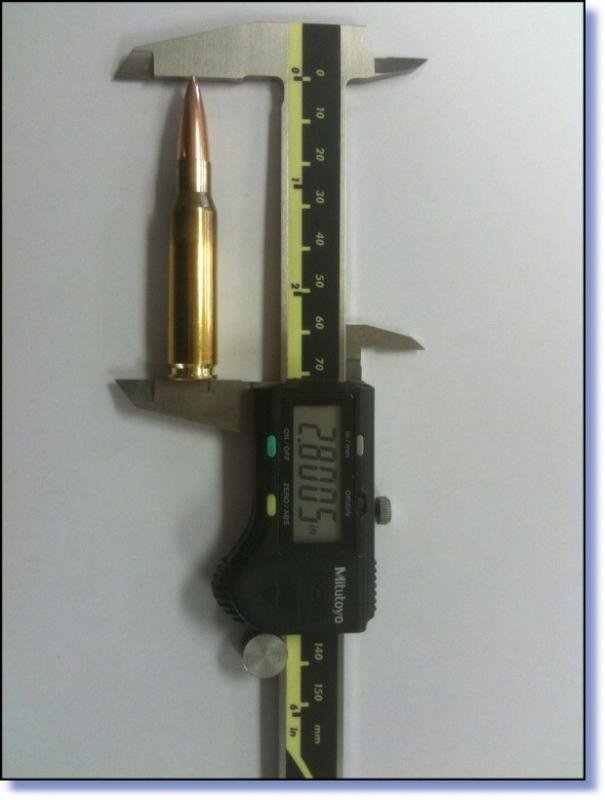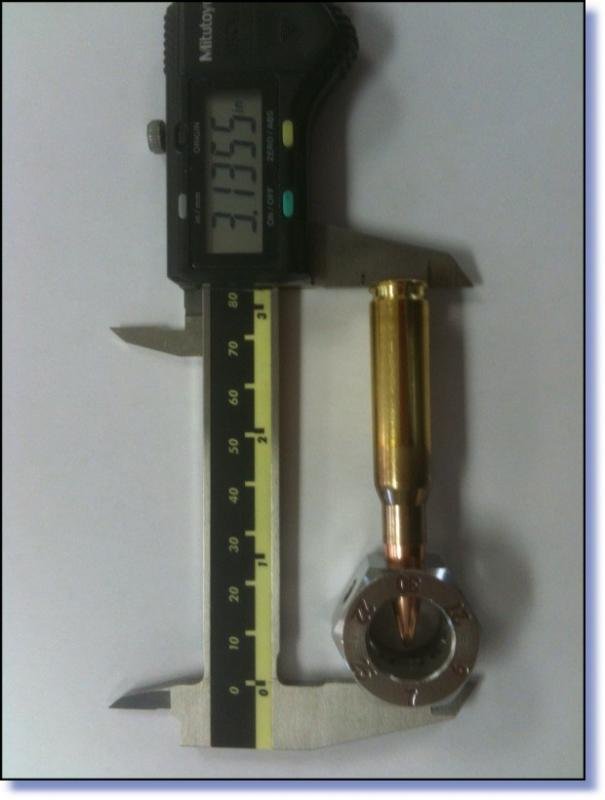Accuracy by the Thousandths
Selecting Bullet Seating Depth for Maximum Rifle Accuracy
by Troy Lawton
United States Army Marksmanship Unit (USAMU)
Custom Firearms Shop website…
Choosing the optimal bullet seating depth for your firearm when handloading is very important. It can significantly affect both accuracy and functioning. Even within the same caliber and even within the same brand there have always been large differences in chamber design. Different chambers may all “fit” a factory cartridge, but there will be a difference in the distance between the back of the cartridge to exactly where the bullet engages the rifling after leaving the mouth of the case upon firing. This measurement can vary greatly within the official SAAMI caliber specification. Factory ammunition will be loaded to the shortest of the specification, so that it will chamber in all guns for that caliber without jamming into the rifling as the action is closed.
 |
| Measuring COAL with a digital caliper. |
In addition to chamber variations, barrel throat erosion due to extensive firing may make it necessary to increase the Cartridge Overall Length (COAL) to maintain the bullet’s desired relationship to the rifling. When a bullet is fired from a gun there is an enormous amount of hot gas trapped in the action under extreme pressure until the bullet leaves the barrel. Even the finest steel can’t stand up to this punishment forever, and one of the places that wear is first evident is at the front of the rifling, where the bullet first engages. The bullet is deformed, or swaged, by the rifling and it is at that point that the friction of the bullet material on the steel of the barrel is most intense. The front of the rifling eventual wears away.
In general, the less distance a bullet has to travel to reach the lands when leaving the cartridge mouth, the better one’s accuracy is apt to be. This travel leaves the bullet unsupported, and longer “bullet jump” to the rifling increases chances of the bullets’ entering the rifling off-center. However, this rule is not always true; handloaders should keep an open mind when experimenting with seating depths to improve accuracy. Sometimes, bullets may perform better with a bit more “jump” to the rifling, rather than less. The techniques discussed here are used by advanced handloaders for competition shooting. However, they also have applications for hunting/long range informal target shooting, especially in bolt action or single-shot rifles.
To begin, some firearms such as repeating bolt actions, lever actions, semi-autos or revolvers require cartridges loaded within certain, specified maximum and minimum lengths to function properly. To use the rifle or pistol as a repeater, one will need to keep overall cartridge length within these parameters. However, accuracy can often be improved by tailoring the COAL to best fit your chamber. This length may exceed the standard “magazine” COAL for repeaters, and require single-loading of each cartridge for the finest accuracy. When developing loads for a new rifle (or with a new bullet design), it’s important to establish the absolute maximum COAL for one’s individual firearm. This is the length at which the seated bullet touches the rifling lands.
 |
| An Overall Length Comparator with a digital caliper. |
One time-honored approach is to barely seat a bullet in the neck of an empty, sized, unprimed case, insert it into the chamber, and attempt to close the bolt or action. If the cartridge will not chamber or requires unusual force to chamber, then adjust the seating die to shorten the cartridge a slight amount, and try chambering it again. Continue to do this in increments until the dummy cartridge will just allow chambering with minimal force on the bolt handle, lever, etc. At this point, polish the bullet with fine steel wool or a metal polish such as “Flitz”, and re-chamber.
Upon extracting the cartridge, look for rifling marks on the bullet. After confirming that your bullet is seated into the rifling, record this maximum COAL in the handloading notes. Afterwards, continue to seat the (re-polished) bullet further into the case in increments until no land marks are left on the bullet, and the bolt closes easily. Record this second, shorter COAL as a starting measurement at which the bullet no longer contacts the lands.
Modern handloading tools can make this procedure much easier and more precise. Handloaders often find a “bullet comparator” or “Overall Length Comparator” helpful. These measure the area where the bullet engages the rifling (ogive), rather than measuring at the bullet’s tip. Depending on many factors, individual bullets, even from the same box, can vary in length by up to ~0.020”. This reduces precision when measuring COAL from tip-to-base of the cartridge. Cartridge ogive-to-base measurements taken with a comparator usually vary only ~0.004” at most, offering significantly greater precision.
Commercially-available chamber length gauges allow the bullet to be seated into a dummy case, chambered, and then pushed forward in the case neck until it touches the lands. That measurement is then recorded; this method saves considerable time. Saving/reusing the exact bullet used for the original measurements allows the handloader to track barrel throat erosion over time. One easy approach is to keep this “reference bullet” in the box with one’s loading dies. Because different bullet designs have different ogive shapes, one should take new measurements whenever beginning load development with new bullet designs. These measurements should always be taken in a clean barrel for best precision.
| I have included a few videos from our high speed cam to give you an idea of how many variables we try to calculate at the USAMU Custom Firearms Shop. This first one is the muzzle exit of 3000 FPS 142gr BTHP from 6.5/284 Match Grade 1000yd Bolt rifle. Click here if you can’t see the video. |
| This is an issue Beretta M9 from a test fixture. Click here if you can’t see the video. |
| This is a match grade M9 from a shooters hand. Click here if you can’t see the video. |
When loading for maximum accuracy, it’s best to start by seating bullets shorter than the maximum COAL at which the bullet engages the rifling. Loading so that bullets touch the rifling increases chamber pressure, while allowing some “jump” to the rifling eliminates this issue. One good COAL to begin accuracy testing is by seating the bullet 0.020” off the rifling. As accurate loads are developed, this COAL may be fine-tuned by decreasing bullet jump to 0.010” or increasing to 0.030”, etc.. Loading with bullets “just touching” the lands can sometimes reduce accuracy, as individual bullet variations may cause some to jump to the rifling, and others to engage it, reducing consistency.
Once you find a given bullet with a given powder (and even batch of powder) at a given powder measurement that works in a rifle well, that is the place you want to be to begin testing the rifle with COAL. Bringing the bullet forward and moving it backward even a few thousands can have measureable outcomes.
You may be asking yourself at this point how on earth you could ever do this twice for the same rifle in two different reloading sessions and have the same outcomes. For one, as I mentioned, throat erosion on rifles especially can change what will be the working COAL as you shoot the rifle over time. This however is not a quick process and for a deer rifle that you sight in once a year and practice a few boxes through here than there, the throat erosion may not be measurable at all. In a competition rifle that may see thousands of rounds in a month, throat erosion is something you should be looking from time to time, especially if what was working in the rifle doesn’t seem to work anymore.
As to actually seating the bullet, there is a specific type of die that has a micrometer built into it. This is extremely practical because you can visibly measure a change in seating depth of .005 without having to remove the case over and over again from the press to the calipers and back again, hoping to nail your test COAL with standard seating die adjustment threads.
Repeatability is everything when it comes to handloading, and you may also be loading for more than one rifle with the same set of dies. So locking a standard die won’t work, leaving you to have to do the same in and out with the press and the calipers every time you reload for that rifle. There are these “competition” bullet seating dies available in all major calibers from Redding, RCBS and Forster.
There is a point in handloading where you feel like there are too many variables that interact with each other to be able to nail any one of them to what is “ideal.” What is ideal in one could be influenced negatively by another, which in turn will handicap your ability to discover the “ideal” of this particular element. In this regard COAL is no different. The burn rate of one powder will affect the ideal overall length over another powder, at least theoretically. Likewise the ogive of a different bullet, or even the jacket thickness of one batch of bullets to another.
Cartridge Overall Length is the fine tuning. It can often make what appears to be a very average performing ammo combination for a given firearm, a great performing combination. Optimizing bullet seating depth is going to give you the ability to compete successfully, or make the shot of a lifetime.
0.0001
the first number to the right of the decimal point is the tenths of an inch = 0.1
the second number to the right of the decimal is the hundredths of an inch = 0.01
the third number to the right of the decimal is the thousands of an inch = 0.001
the fourth number to the right of the decimal is ten thousands of an inch = 0.0001
You still loading bullets for the MTU I see!
If you get back into Northeast Louisiana stop and stay over night again!
Take care!
What do you consider using a digital caliper reading at 1000/of an inch being .001 or .010 This is confusing for me, and what do you consider being safe that is far enough from the lands, .001 or .010 and start working backwards to .002 or .020
Thanks for the help.
It is .001. So 20 thousands is .020.
There are varying opinions as to both the pressure increase and effectiveness of seating a bullet close to the lands to prevent “jump.” No opinion on either from me sorry.
Administrator, I think you are confused. 0.001 equals one one thousandth.
Ben, you are confused. .020 is both 2 hundredths as well as 20 thousandths. Different lingo, same meaning. Administrator is correct.
Very good article. I am a beginning reloader and have been experimenting with COAL. I have a Marlin 30-30 Lever Action Tube feed and like going to the range to shoot, also used for hunting. I made a simple method to check coal, a empty new cartridge and put slits in it, put in a bullet and chambered it several times. Each measurement was 2.562. A question, my coal is generally 2.550 as specified by the bullet manufactures, using 2.550-2.562=.012 but if I used coal 2.551-2.562=.011 or coal 2.552-2.562=.010 would this still be safe and increase accuracy or could I perhaps go a bit closer. I know that this is not the most accurate method for measuring ogive but will is work sufficiently.Thanks.
Dave